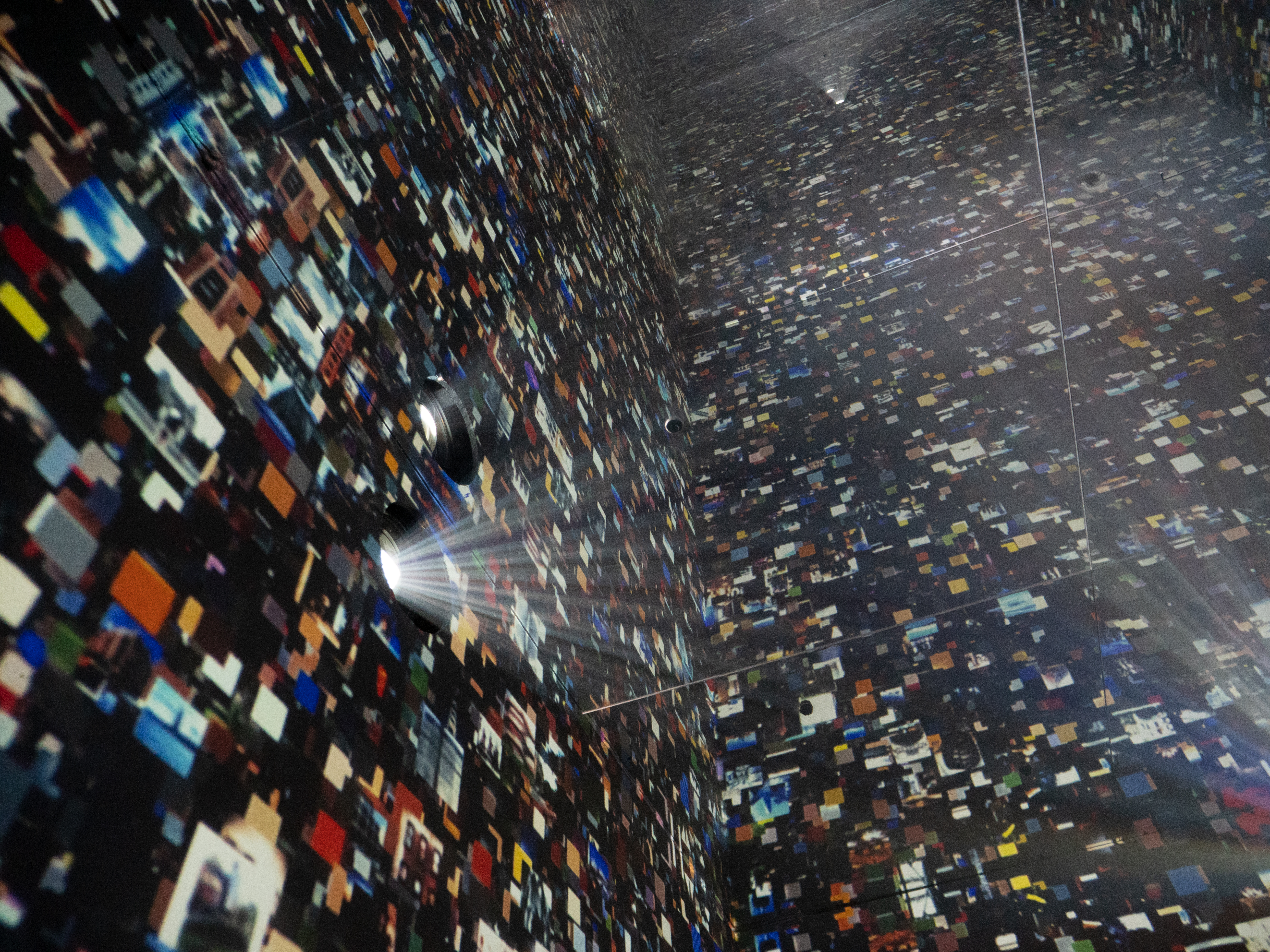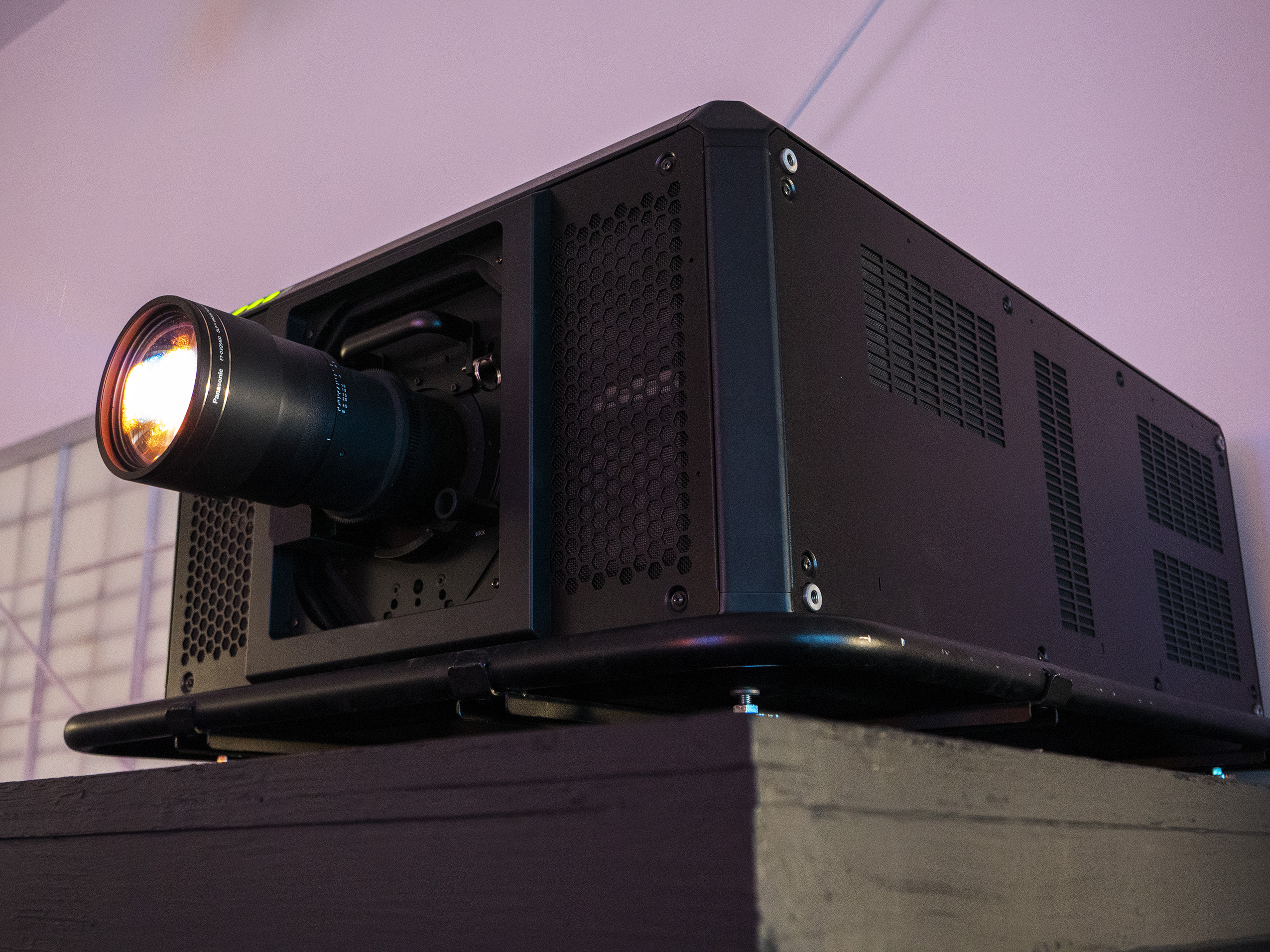August 24, 2020
4 min read
Challenge
Acclaimed media artist and director, Refik Anadol, creates world-renowned site-specific public art, and orchestrates live audiovisual performances, exhibitions and installations throughout the world. Recently, Anadol worked with the Los Angeles Philharmonic (LA Phil) for its centennial season to celebrate both the orchestra’s history and its future. With the aim to use The Frank Gehry-designed Walt Disney Concert Hall (WDCH) as a canvas, he needed a solution that could project crisp, bright and clear images onto a unique, reflective outside exterior.
Separately, Anadol held an open house at his Los Angeles studio for the Frieze Los Angeles art fair, with the goal to transition traditional surfaces into unexpected visuals.
With both of these art exhibitions, he needed to find a way to ensure the light could be captured clean and clear in the air, without any distortion or alteration – Anadol is constantly trying to find ways to make light more visible.
Solution
Anadol selected Panasonic’s projection technology to create unique and captivating visuals that were able to alter the reflective surfaces of the WDCH and transform traditional backdrops into innovative visual designs during Frieze Los Angeles.
For the LA Phil, Anadol trained machine learning algorithms on the orchestra’s extensive digital archives – 45 terabytes of data – to create the public art installation, WDCH Dreams. To project stunning visuals based on this dataset, Anadol used 42 large venue laser projectors, including Panasonic’s PT-RZ31KU 3-Chip DLP® SOLID SHINE laser projectors.
At Frieze Los Angeles, Anadol used the world’s smallest[1] 50,000 lumens 3-Chip DLP® SOLID SHINE projector, Panasonic’s PT-RQ50KU, to alter flat surfaces into distinctive textures. In his second Frieze installation, Infinity Room, Anadol utilized a “silky fine mist” created by Panasonic’s Green Air-Conditioner as the backdrop for holographic visuals. To produce the dreamlike setting, Anadol used Panasonic’s PT-RZ120U 1-Chip DLP® fixed installation laser projectors, each with a wide-angle ET-DLE060 lens to project onto the mist.
Result
For both installations, Panasonic’s laser projectors enabled Anadol to implement immersive and engaging visual experiences by projecting stunning, clear and crisp visuals onto a variety of surfaces, bringing Anadol’s artistic visions to life.
Commenting on his work with Panasonic technology, Anadol reveals, “We feel privileged to use one of the best machines in the world, work with some of the best engineers in the world who can tackle big problems using light or mist as a material. I’m really grateful to connect cutting edge laser projection technology with cutting edge art to create something purposeful and beautiful.”
Refik Anadol’s Infinity Room
Projecting Art That Goes Beyond the 3rd Dimension
Born in Istanbul, Turkey, Refik Anadol is now a Los Angeles-based artist as well as a lecturer and visiting researcher at the University of California Los Angeles. With works that have been presented internationally, Anadol primarily focuses on site-specific public art that explores digital and physical spaces by creating a hybrid relationship between architecture and media arts.
Through audiovisual performances, Anadol aims to transform the traditional subject of contemporary culture within his work, so viewers are guided towards interactions with unconventional spatial orientations where they can build a more unique understanding of space. He accomplishes this by embedding media arts into architecture, showcasing that all spaces and facades have the potential to be utilized as a “canvas.” In order to achieve this in his recent work with the Los Angeles Philharmonic (LA Phil) and the Frieze Los Angeles Art Fair, Anadol turned to Panasonic’s projection technology.
To celebrate the LA Phil’s centennial season, Anadol chose to transform The Frank Gehry-designed Walt Disney Concert Hall (WDCH) into a canvas that bridged that gap between the orchestra’s one hundred year history and its bright future. However, because the concert hall is comprised of a shiny, stainless steel exterior, any projection technology used had to be bright enough to combat the reflective surface. To achieve WDCH Dreams, Panasonic’s PT-RZ31KU 3-Chip DLP® SOLID SHINE laser projectors transformed the exterior of WDCH into animated, data-driven patterns that breathed life into the architectural landmark. Anadol commented that only with “enormously powerful projection” could this have been achieved on a reflective surface in the middle of a city riddled with light pollution.
Separately, Anadol utilized Panasonic projection during the Frieze Los Angeles art fair where his first exhibit was a triptych, otherwise known as a work of art that is divided into three sections. However, instead of utilizing oils and acrylics as you might find in traditional triptychs, Anadol chose to create artificial intelligence data paintings. To showcase data as an artistic medium, Anadol used the PT-RQ50KU 3-Chip DLP® SOLID SHINE laser projector due to its bright, sharp, color-accurate capabilities to transform blank canvas into textured pigment. While the PT-RQ50KU is typically used in large venues, Anadol chose to deploy it on a smaller scale to maximize its brightness. This resulted in the illusion of multiple layers and dimensions on a small-scale, flat surface right before the viewers’ eyes.
Panasonic's PT-RQ50KU 3-Chip DLP® Laser Projector
Anadol’s second exhibit at Frieze Los Angeles, Infinity Room, was inspired by a childhood dream of a door that opened to an alternate dimension. As viewers entered the room, they were transported into a world of complete immersive irregularity where no floors or walls existed. Panasonic’s PT-RZ120U 1-Chip DLP® fixed installation laser projectors, each with a wide-angle ET-DLE060 lens, produced the dreamlike setting onto thin mist which was created using Panasonic’s Green Air-Conditioner. The effect was a holographic environment that brought viewers into the mind of the artist.
“Refik is a pioneer in new technologies continuously challenging the status quo to come up with new possibilities in his artwork,” says Brian Duffy, Business Development, Panasonic. “Artists like Refik inspire Panasonic to be on the forefront of innovation.”
For more information on Refik Anadol’s work with Panasonic, hear from the artist firsthand:
Footnotes:
[1] For laser-phosphor projectors in the single-body 50,000 lumens class or higher, as of February 2019


